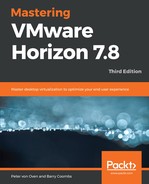With the certificate server installed and configured, we are now going to install the newly created certificate on the View Connection Server:
- Open a remote console session to the View Connection Server named HZN7-CS1, and then open a Run command box. In the Run box, type mmc, and then click on OK to launch the Microsoft Management Console (MMC), as shown in the following screenshot:

- You will now see the MMC console screen, as shown in the following screenshot:

- On the MMC console screen, click on File (1), and then click on the option for Add/Remove Snap-in… (2).
- You will now see the Add or Remove Snap-ins screen:

- From the Available snap-ins section on the left, click to highlight the Certificates entry (3), and then click, the Add > button (4), as shown in the previous screenshot.
- You will now see the Certificates snap-in box appear, as shown in the following screenshot:

- Click on the radio button for Computer account (5), and then click the Next > button to continue. You will now see the Select Computer configuration box:

- Click on the radio button for Local computer (6), and then click on the Finish button. You will return to the Add or Remove Snap-ins screen, which now shows the certificates snap-in as being selected.
- Click on OK to close the Add or Remove Snap-ins screen.
You have now successfully added Certificates to the management console as an option for configuration, as shown in the following screenshot:

Now you have the certificates available to manage and configure from the management console, the next task is to request a certificate from the root CA:
- From the Console Root, expand the Certificates (Local Computer) folder, and then right-click on the Personal folder (1). From the contextual menu, navigate to All Tasks (2) and then select Request New Certificate... (3):

- You will now see the Before You Begin section on Certificate Enrollment screen. Click on the Next button to continue.
- Now the Select Certificate Enrollment Policy screen is displayed, as shown in the following screenshot:

- Click on the Next button to continue. You will now see the Certificate Enrollment Request Certificates screen:

- In the Active Directory Enrollment Policy box, check the box for Computer (4). We will use this policy template for our certificate; however, you can create your own template on the root CA server.
- Now click on the arrow next to Details (5), and then click on the Properties box (6) so that we can configure the properties of the certificate. You will now see the Certificate Properties configuration box, as shown in the following screenshot:

- Click on the General tab (7), and then in the Friendly name: box (8), type in a friendly name for this certificate. In the example lab, we will call this vdm. Optionally, you can enter a Description as well.
- Next, from the Certificate Properties box again, click on the Private Key tab, as shown in the following screenshot:

- Click on the down arrow for Key options (10) to expand the configuration options, and check the box for Make private key exportable (11).
- Finally, click on the Certification Authority tab (12), as shown in the following screenshot:

- Check the box to select the pvolab-HZN7-CERTS-CA (13) enrollment server. Now click on the OK button. You will return to the Request Certificates screen, as shown in the following screenshot:

- Click on the Enroll button (14) to continue and enroll the Connection Server. If the enrollment is successful, then you will see the following screenshot:

- Click the Finish button to complete the certificate enrollment process.
Don't forget that you need to complete the certificate enrollment process on all of the Horizon View components, so if you have additional servers such as Replica Servers and View Composer Servers then these will all need a certificate to be installed on each and every one of them.
In the next section, we will take a look at what to do now that we have our root CA certificate server and the certificate is installed on our Connection Servers.
